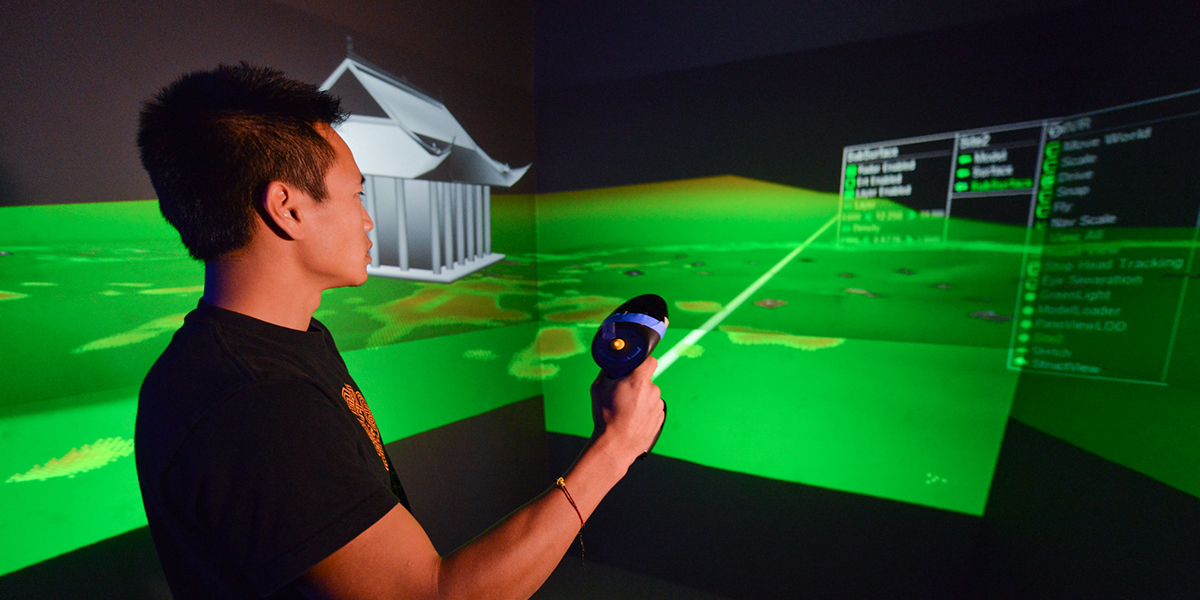Albert Lin '05, '06, '08, a National Geographic explorer and UC San Diego Qualcomm Institute (QI) scientist, stands in front of the Cholon waterfalls during his quest to find the lost city of the Chachapoyas in Peru as part of a new show, "Lost Cities Revealed." (National Geographic for Disney/Alejandra Velez)
Image 1/9
Albert Lin travels by horseback at Al-Khazneh in Petra, Jordan. "All these different locations are part of this big adventure," he says, "and they’ve been picked to highlight certain aspects of our humanity that are universal, like themes of resilience or working together, or how we organize ourselves." (National Geographic)
Image 2/9
Holding a light tube, Albert Lin studies ancient Pict symbols inside Sculptor’s Cave in Scotland, as part of the search for the lost city of the Picts. (National Geographic for Disney/Katy Savage)
Image 3/9
“With symbolism, ritual and buildings or structures, from our earliest civilizations to now, our physical world is constructed in some kind of marriage between the tangible and the intangible,” says Albert Lin. Shown here is the Temple of Inscriptions at the archaeological site of Palenque, which contains the tomb of King Pakal the Great, in Palenque, Chiapas, Mexico. (National Geographic for Disney/Katy Savage)
Image 4/9
Albert Lin points toward Red Mountain, as he approaches it by boat with archaeologist Arcelia García Sánchez, rower Kin and Maya guide Bore Juan in Mensabak, Chiapas, Mexico. The team reveals one of the oldest, largest, Pre-Classical Maya cities ever found hidden deep in Mexico’s Lacandón jungle. (National Geographic for Disney/Jahlani Clarence)
Image 5/9
Duncan Lees, Albert Lin, Valentina Azzara, Joseph Steel, and another team member look at a Visual Skies screen displaying images captured with a heat camera that reveal human-made structures under the sand in Oman. "Engineering and technology allow you to invent or imagine the tools, or the way to use tools, that can let you go beyond barriers to new frontiers," Lin says. (National Geographic for Disney/Solomon Taan)
Image 6/9
A computer-generated LiDAR image from “Lost Cities Revealed with Albert Lin: The Warrior Kings” shows an “island” at Nuri site in Sudan. (National Geographic)
Image 7/9
Albert Lin immerses himself in the possibilities of using technology for exploration during his early days at the Qualcomm Institute (QI) at UC San Diego. "It was inspiration from what was happening in [QI’s] Atkinson Hall that truly got me started," he says. "It does feel to me that part of the footprint of QI is in... the very concept of looking for the unknown."
Image 8/9
"It’s remarkable to feel we’re alive in an Age of Discovery," says Albert Lin, shown here in search of Napata, the capital city of the Kingdom of Kush, a powerful, eighth-century African civilization in Sudan. "I think, 100 years from now, people will look back and say, 'Wow, that was an important time.' ... I feel very lucky to be a part of telling that story." (National Geographic for Disney/Solomon Taan)
Image 9/9












